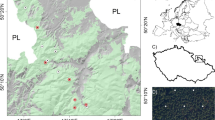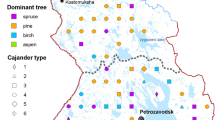Abstract
Windthrow, i.e. the felling of trees by wind, occurs continually in forest ecosystems. The uprooting of old trees creates multiple microsites (e.g. pit and mound landscape) that are the main source of soil heterogeneity. To determine the impact of pit and mound landscapes on soil features, a beech forest of the Langa district (Mazandaran province, Northern Iran) was studied. An area of 25 ha was considered for this study wherein three microsites were distinguished, including pit bottom (pit), mount top (mound) and level areas (closed canopy). In this area, 22 uprooted trees were also found. Soil samples were collected at different depths (i.e. 0–15, 15–30 and 30–45 cm) from all microsites and analysed. Our study shows that windthrow events should be considered as an important factor in influencing forest ecosystem, as they affect physical (i.e. density, texture and water content), chemical (i.e. pH, organic C, total N, cation exchange capacity and available nutrients) and biological (i.e. soil microbial respiration and earthworm density/biomass) characteristics of soil, thus resulting in pit and mound microsites that may strongly differ with respect to the closed canopy.




Similar content being viewed by others
References
Alef K (1995) Estimating of soil respiration. In: Alef K, Nannipieri P (eds) Methods in soil microbiology and biochemistry. Academic Press, New York, pp 464–470
Allison LE (1975) Organic carbon. In: Black CA (ed) Methods of soil analysis. Part 2. American Society of Agronomy, Madison, pp 1367–1378
Amador JA, Glueksman AM, Lyons JB, Gorres JH (1997) Spatial distribution of soil phosphatase activity within a riparian forest. Soil Sci 162:808–823
Bouyoucos GJ (1962) Hydrometer method improved for making particle size analysis of soils. Agron J 54:464–465
Bower CA, Reitemeier RF, Fireman M (1952) Exchangeable cation analysis of saline and alkali soils. Soil Sci 73:251–262
Bremner JM (1965) Inorganic forms of nitrogen. In: Black CA (ed) Methods of Soil Analysis, part 2. Chemical and microbiological properties. American Society of Agronomy, Madison, pp 1179–1237
Bremner JM, Mulvaney CS (1982) Nitrogen—total. In: Page AL, Miller RH, Keeney RR (eds) Methods of soil analysis, Part 2, 2nd edn. American Society of Agronomy, Madison, pp 595–624
Deleporte S (2001) Changes in the earthworm community of an acidophilus lowland beech forest during a stand rotation. European J Soil Biol 37:1–7
Edwards CA, Bohlen PJ (1996) Biology and ecology of earthworms, vol 3. Chapman and Hall, London, p 426
Frelich LE (2002) Forest dynamics and disturbance regimes. Cambridge University Press, Cambridge, p 280
Hassannezhad H, Pashaee A, Khormali F, Mohammadian M (2008) Effect of soil moisture regime and rice cultivation on mineralogical characteristics of paddy soils of Mazandaran Province, Northern Iran, Amol. Int J Soil Sci 3:138–148
Homer CD, Pratt PF (1961) Methods of analysis for soils, plants and waters. University of California, Agricultural Sciences Press, Berkeley, p 309
Janášová M, Vrávrová E, Cudlín P (2010) Western Carpathian Mountain spruce forest after a windthrow: natural regeneration in cleared and uncleared areas. For Ecol Manage 259:1127–1134
Karlen DL, Rosek MJ, Gardner JC, Allan DL, Alms MJ, Bezdicek DF, Flock M, Huggins DR, Miller BS, Staben ML (1999) Conservation Reserve Program effects on soil quality indicators. J Soil Water Conserv 54:439–444
Kooch Y, Hosseini SM (2010) Response of earthworms biomass and diversity to windthrow events and soil properties in Hyrcanian forests of Iran. Folia oecologica 37:181–190
Kuzyakov Y, Friedel JK, Stahr K (2000) Review of mechanisms and quantification of priming effects. Soil Biol Biochem 32:1485–1498
Lee KE (1985) Earthworms: their ecology and relationships with soils and land use. Academic Press, Sydney, Australia
Liechty HO, Jorgensen MF, Mroz GD, Gale MR (1997) Pit and mound topography and its influence on storage of carbon, nitrogen, and organic matter within an old-growth forest. Can J For Res 27:1992–1997
Lohmander P, Mohammadi Limaei S (2008) Optimal continuous cover forest management in an uneven-aged forest in the north of Iran. J Appl Sci 8:1995–2007
Londo AJ, Mroz GD (2001) Bucket mounding as a mechanical site preparation technique in wetlands. NIAF 18:7–13
Ma C, Eggleton RA (1999) Cation exchange capacity of kaolinite. Clay Clay Miner 47:174–180
Marvie Mohadjer MR (2007) Silviculture. Tehran University Press, Tehran, p 387
Moore F, Esmaeili A (2012) Mineralogy and geochemistry of the coals from the Karmozd and Kiasar coal mines, Mazandaran province Iran. Int J Coal Geol 96–97:9–21
Nachtergale L, Ghekiere K, De Schrijver A, Muys B, Luyssaert S, Lust N (2002) Earthworm biomass and species diversity in windthrow sites of a temperate lowland forest. Pedobiologia 46:440–451
Neirynck J, Mirtcheva S, Sioen G, Lust N (2000) Impact of Tilia platyphyllos Scop., Fraxinus excelsior L., Acer pseudoplatanus L., Quercus robur L. and Fagus sylvatica L. on earthworm biomass and physico-chemical properties of a loamy topsoil. For Ecol Manage 133:275–286
Norton JB, Sandor JA, White CS (2003) Hillslope soils and organic matter dynamics within a native American agroecosystem on the Colorado Plateau. Soil Sci Soc Am J 67:225–234
Pennock DJ, McCann BL, de Jong E, Lemmen DS (1999) Effects of soil redistribution on soil properties in a cultivated Solonetzic-Chernozemic landscape of southwestern Saskatchewan. Can J Soil Sci 79:593–601
Peterson CJ (2007) Consistent influence of tree diameter and species on damage in nine eastern North America tornado blowdowns. For Ecol Manage 250:96–106
Phillips JD, Marion DA, Turkington AV (2008) Pedologic and geomorphic impacts of a tornado blowdown event in mixed pine-hardwood forest. Catena 75:278–287
Plaster EJ (1985) Soil science and management. Delmar Publishers Inc., Albany, p 124
Robertson GP, Coleman DC, Bledsoe CS, Sollins P (1999) Standard soil method for long-term ecological research. Oxford University Press, Oxford, p 462
Saggar S, Hedley CB, Salt GJ (2001) Soil microbial biomass, metabolic quotient, and carbon and nitrogen mineralisation in 25-year-old Pinus radiata agroforestry regimes. Aust J Soil Res 39:491–504
Sagheb Talebi Kh (2000) Hyrcanian forests (North of Iran), the unique ecosystem in near east region. In: Krishnapillay B (ed), Proceeding, XXI IUFRO World Congress—Forests and Society: The role of research, Kuala Lumpur, Malaysia
Samonil P, Antolik L, Svoboda M, Adam D (2009) Dynamics of windthrow events in a natural fir-beech forest in the Carpathian Mountains. For Ecol Manage 257:1148–1156
Scharenbroch BC, Bockheim JG (2007) Pedodiversity in an old-growth northern hardwood forest in the Huron Mountains, Upper Peninsula, Michigan. Can J For Res 37:1106–1117
Stevenson FJ (1986) Cycles of soil. Carbon, nitrogen, phosphorus, sulphur, micronutrients. Wiley, New York
Stevenson FJ (1994) Humus Chemistry. Genesis, composition, reactions, 2nd edn. Wiley, New York
von Oheimb G, Friedel A, Bertsch A, Hardtle W (2007) The effect of windthrow on plant species richness in a Central European beech forest. Plant Ecol 191:47–65
Wood M (1995) Environmental soil biology, 2nd edn. Blackie Academic and Professional, Glasgow, p 150
Author information
Authors and Affiliations
Corresponding author
Additional information
Communicated by A. Merino.
Electronic supplementary material
Below is the link to the electronic supplementary material.
Rights and permissions
About this article
Cite this article
Kooch, Y., Zaccone, C., Lamersdorf, N.P. et al. Pit and mound influence on soil features in an Oriental Beech (Fagus orientalis Lipsky) forest. Eur J Forest Res 133, 347–354 (2014). https://doi.org/10.1007/s10342-013-0766-2
Received:
Revised:
Accepted:
Published:
Issue Date:
DOI: https://doi.org/10.1007/s10342-013-0766-2




